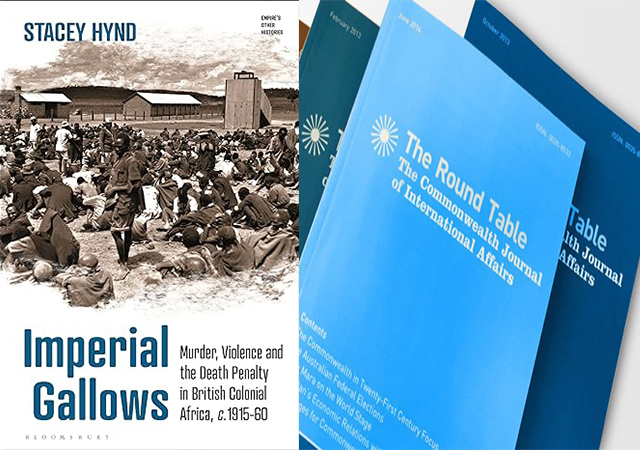
[This is an excerpt from an article in The Round Table: The Commonwealth Journal of International Affairs.]
This is an important book, formidably researched, soberly judged, attractively written, with big ideas brought to life in dramatic, distressing, episodes. Imperial Gallows will be widely cited in all future debate on the historical nature and contemporary legacies of the British empire in Africa. With scrupulous balance Hynd provides evidence for both those who see little other than racist violence and greed in imperial history, and for those prepared to judge imperial motives and processes as comparable with all other exercises of power, generally contradictory as they are in their complexities of brutality and humanity, profit and decency, purpose and confusion, confidence and panic, disdain and respect for subject peoples.
Stacey Hynd sets out the philosophy, logic, utility, and morality of imperial capital punishment in Africa before then going on to examine its variable geography and changing history. Contradiction sat at its heart. The gallows were a two-sided political weapon. On the one hand, for a colonial state to kill under law demonstrated its sovereign power, even its civilising power. Capital punishment could be said to serve as a ‘didactic deterrent’ in disciplining unruly populations – a view in which the assumption of white racial superiority played its insidious part. On the other hand, a racist paternalism that believed Africans to be different – superstitious, excitable, and so on – raised morally queasy questions about how far they could be held criminally responsible for murder, and doubt over the justice, therefore, of the ultimate penalty. Hynd gives stark statistical proof that racism worked in both these ways. In the quarter century after 1930, in populations roughly equal in number, ten times more Africans were hanged in British Africa than Britons in the United Kingdom. Yet colonial governors, empowered with the royal prerogative of mercy, commuted forty per cent of the capital sentences that passed across their desks to terms of imprisonment. To execute blacks apparently aroused little political comment in that era; nonetheless, as primitive peoples they deserved some benefit of the doubt. The thought that they could not be expected to know any better was especially persuasive in cases where the killer believed his victim to be a witch, a bearer of intimate or social evil. As time went on witch-murderers were almost all spared the rope but imprisoned all the same – to prove to many Africans the profoundly anti-social nature of colonial rule in punishing those who acted to protect them from the occult.
Bookshelf from The Round Table Journal
These generalities were varied in practice. We are often told that the empire was an accidental mosaic, spatchcocked together in different contexts, without overall design or purpose. This was certainly true of colonial Africa’s penal regimes. From the outset British district officers tried to administer a justice that would not offend the sense of justice held by people under their often questionable control. To enquire into ‘native law’ was often their first concern. A myriad of definitions and tolerances emerged, depending on the severity of the existing African legal code, stern under kingdoms like Asante or Buganda, but more inclined to reconciliation than retribution among Africa’s stateless peoples. Imported legalities also differed, with residues of Dutch and Danish occupations remaining in the Gold Coast, and the sometimes bewildering application of the Indian Penal Code in British East Africa.
The character and choreography of penal practice also changed over time. In some early, nervous, colonial years and, later, at times when the British felt under unusual threat, public execution was justified: the natives simply had to be made to understand. More generally, by the middle of the 20th century, when the legality of the death sentence came under question among European publics, colonial law officers became increasingly concerned to hide the act of judicial homicide, in the fear that its violence did more to question than support colonialism’s self-asserted civilising mission. Under the pressure of African revolt such scruple was cast aside, to be reasserted with some difficulty against local white opinion.
John Lonsdale, Trinity College, Cambridge.
Imperial gallows: Murder, violence and the death penalty in British colonial Africa, c. 1915-60 by Stacey Hynd, London, Bloomsbury, 2024.



